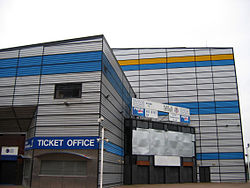London Docklands Arena
| London Docklands Arena | |

The London Arena, seen before demolition
|
|
| Location | East London, England |
|---|---|
| Capacity | 15,000 |
| Construction | |
| Opened | 1989 |
| Renovated | 1998 |
| Closed | 2005 |
| Demolished | 2006 |
| Tenants | |
|
London Knights (ice hockey) London Towers (basketball) Greater London Leopards (basketball) |
|
The London Arena (also known as London Docklands Arena) was an indoor arena and exhibition centre, on the Isle of Dogs, in east London, England; it was demolished for housing in 2006. Seating capacity was up to 15,000, depending on the type of event held. It was the home of the London Knights ice hockey team, the London Towers basketball team and later the Greater London Leopards basketball team.
First opened in 1989, the arena had a £10 million refit in 1998, allowing the capacity of the arena to be altered hydraulically. The arena could seat up to 12,500 people. Events ranged from ice hockey and boxing through to music concerts and trade exhibitions.
Spectacor Management Group (SMG), the world's largest private facility management company, took over ownership of the London Arena in 1994. The company managed arenas and stadiums in the US and Europe, including the Louisiana Superdome, the Mile High Stadium in Denver and the Ullevaal Stadium in Oslo. During 1998, SMG entered into a partnership agreement with another American based company, Anschutz Sports Holdings, to hold an equal share in the ownership of London Arena.
One of the primary reasons for the refit by joint owners, Anschutz, was to introduce professional ice hockey back to London. Along with this, the brief given to architects, HOK Sport, was to turn the arena into a major multi-entertainment centre. This involved introducing a permanent Olympic-size ice rink, 48 luxury hospitality boxes with views over the arena, two brand new team dressing rooms, a completely refurbished foyer and box office, plus a state-of-the-art SACO SmartVision video scoreboard, the only one of its kind outside the US.
However, the arena continued to struggle to attract visitors and it never managed to become a financial success, in part due to its comparatively isolated geographical position and poor local road transport access, although it was well served by the Crossharbour and London Arena DLR station, which has since been renamed to simply Crossharbour (in 2007).
...
Wikipedia
